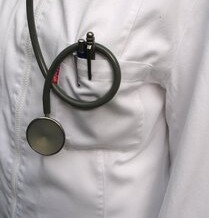Shingles Disease – Cause, Characteristics, Symptoms, Treatments
|

|
Shingles, or herpes zoster, is a disease characterized by a painful rash with blisters. The rash often appears in stripes on the skin.
Shingles is the result of infection with the varicella zoster virus, commonly known as chicken pox. Upon infection with this virus, acute illness occurs in the form of “chicken pox,” a rash of small pock-like marks on the skin. This is generally short-lived and primarily occurs in children and young people.
Once an episode of illness has resolved, the virus remains in the body and can go on to cause shingles – often many years after the initial episode. Thus, shingles is traditionally a disease of adulthood; herpes zoster is often painless in the pediatric population.
An important part of addressing a shingles outbreak is recognizing the early signs and symptoms. Headache, fever, and malaise often accompany shingles but are rarely helpful in identifying shingles, since they are symptoms of many diseases. Conversely, shingles has some specific symptoms that may help with early identification and intervention. Sensations of itching, increased skin sensitivity, burning pain, and “pins and needles” sensations are often present. The pain can be mild to extreme and is often accompanied by intermittent “stabs” of intense pain.
After the initial phase of herpes zoster infection, its characteristic skin rash develops. This phase can last anywhere between a few days to a few weeks. Generally, a rash similar to that which accompanies an allergic reaction (that is, a hive-like rash) appears upon the torso – though the rash can also be present upon the face, lower extremities, or other parts of the body. A distinguishing characteristic of herpes zoster is its tendency to appear upon one section of the body (as opposed to everywhere, like hives). Shingles generally occurs in a “stripe” pattern, and does not cross the body’s midline.
As shingles progresses, the rash forms vesicles, or small blisters; during this time, fever and other early symptoms persist and may increase in intensity. The blisters become discolored as they fill with blood and/or other exudate. In seven to ten days, the blisters form a “crust,” which allows the skin to heal before eventually falling off. In some cases, scarring does occur.
Shingles recurrence is quite rare, and more than three repeated attacks is extremely rare. The majority of sufferers are more than 50 years old, but have had the virus for many years, since shingles only occurs in individuals who have had chicken pox. Usually, the immune system prevents the virus from reactivating, but as the aging process inhibits immunity or immuno-compromise occurs for another reason, the road is paved for shingles to develop.
Treatment for shingles is often focused on alleviating symptoms. Simple measures – such as peppermint tea for general malaise – can be helpful in dealing with this illness. Another important focus is reducing the risk of complications, which can prolong and worsen shingles. Allowing the blisters to heal naturally, as well as administering first aid measures to reduce the risk of infection (i.e. antimicrobial ointments) are excellent ways to limit the severity of shingles.
Shingles can be diagnosed upon visual inspection in most cases, and a doctor should be consulted immediately if complications are suspected. Ultimately, herpes zoster must clear up, thereby alleviating symptoms, but there are many ways – both pharmacological and non-pharmacological – that can alleviate some of the difficulties of coping with shingles.
Author
This article was written for Insights-on-Health.com by Nicole D T, a freelance writer who researches and writes on various topics.
|
Follow this site
|


















Recent Comments